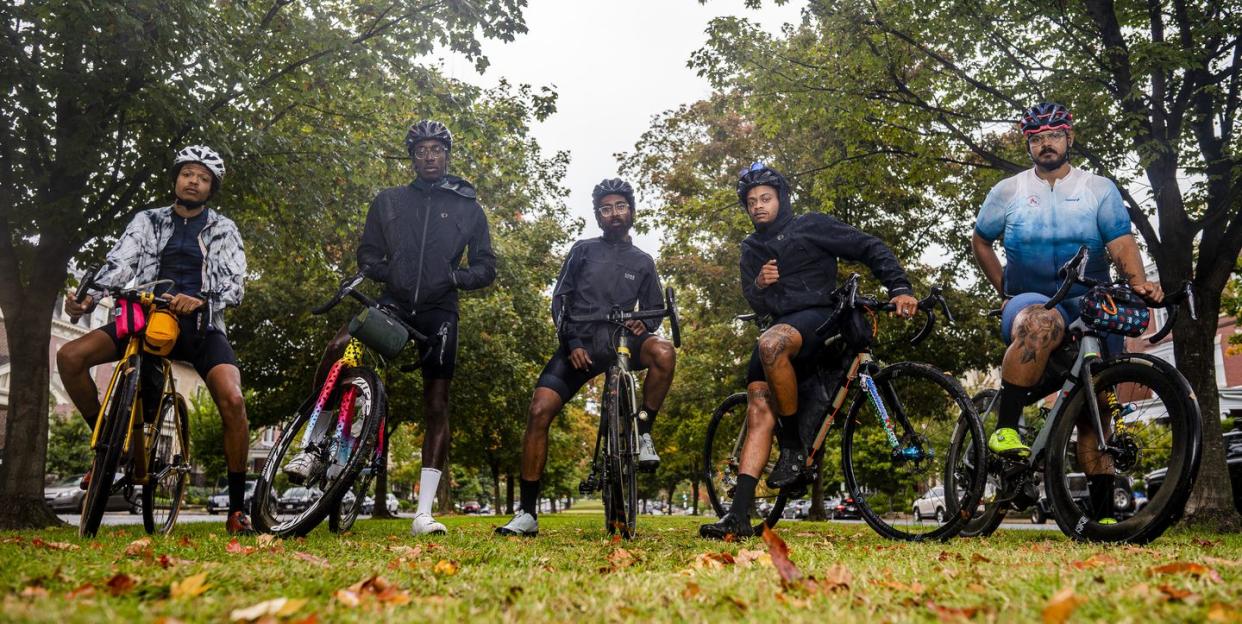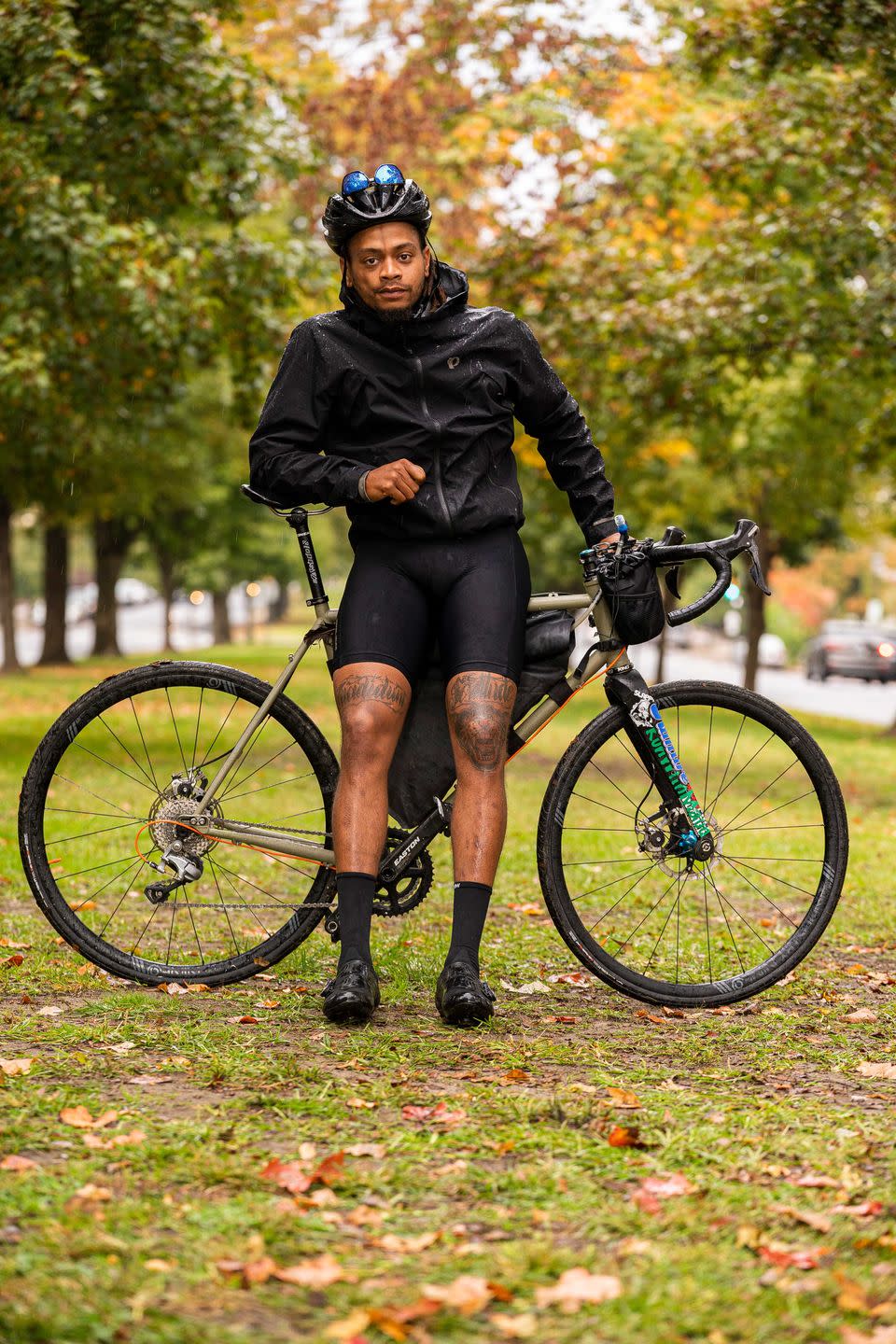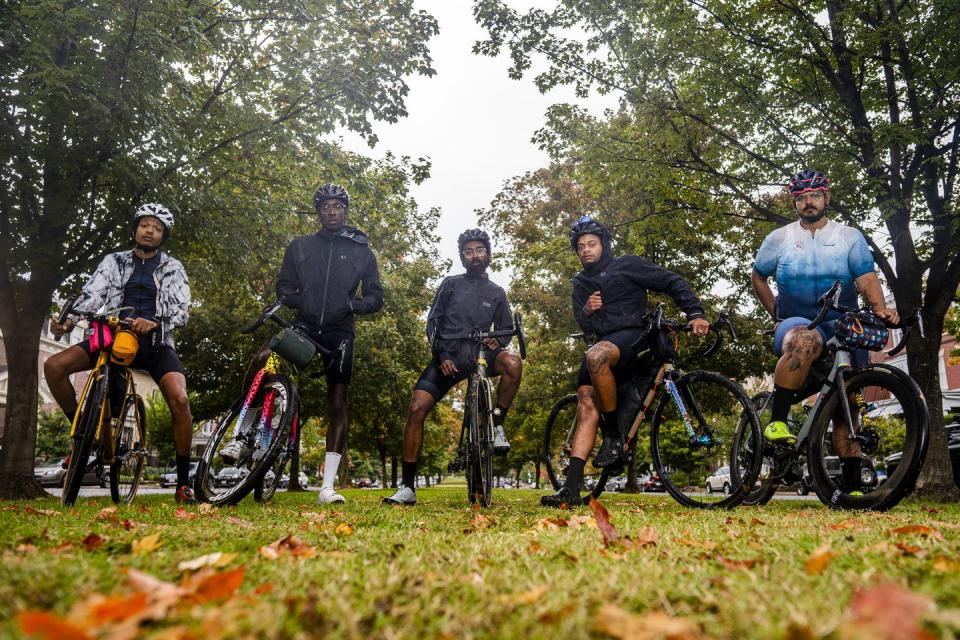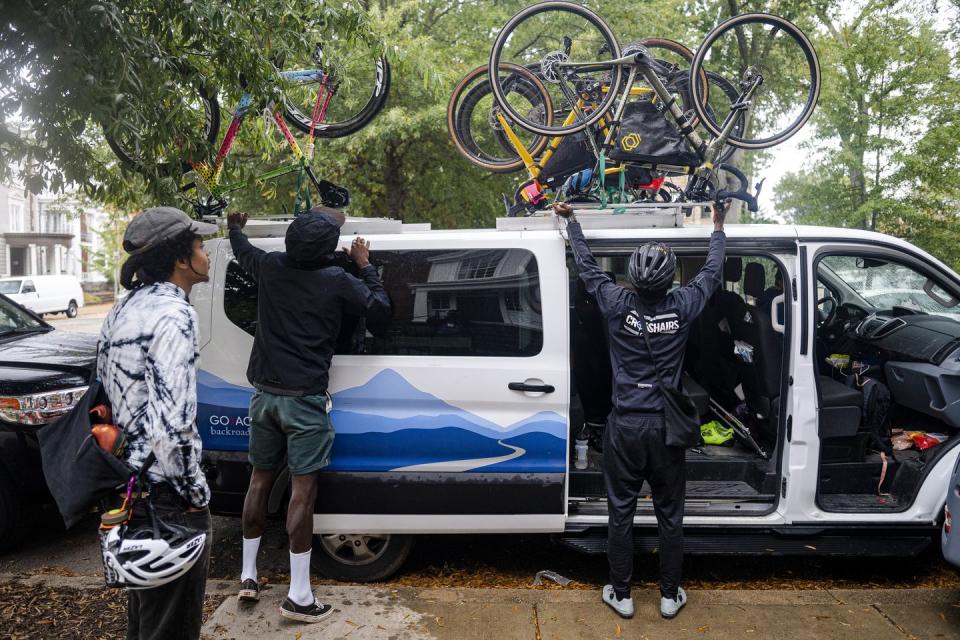To Honor the Spirit of Their Ancestors, They Rode 1,100 Miles on the Underground Railroad

It’s late afternoon in Alabama, a comfortable 70 degrees. Five Black and Latinx men ride their bikes on the side of Highway 21, a two-lane road, heading north. John Shackelford and two others are in the lead; two more riders are about a half mile behind them. Shackelford is hewing close to the median when he receives a call from one of the stragglers: Slow down. He stops and turns around as a giant SUV whips past. When the guys bringing up the rear finally catch up and describe what happened, the group cements a new rule: Don’t leave anybody behind, ever. This could have been a nightmare.
The stragglers explain that as they were riding, the aforementioned SUV had darted from the left lane and stopped on the shoulder, between them and the riders up ahead. A middle-aged white man climbed out of the SUV’s passenger seat and started walking toward them, reaching for something at his hip. Your mind goes places when you hear that, places unarmed Black people can’t avoid, places you go when being Black and minding your own business is taken as an existential danger.
Shackelford had organized this 1,100-mile ride, this tracing of the Underground Railroad from Alabama to Washington, D.C., as a goodwill attempt to inspire his community. But there on Highway 21, it morphed into an uneasy scene tinged by the anxiety of a culture still inflamed over the police killings of George Floyd and Breonna Taylor. Shackelford thought of the four friends he had dragged with him into this mess. Were his good intentions about to add five more names to the struggle?
• • •
An auto fabricator and bike messenger from Brooklyn, Shackelford, 26, is always game for a grand tour—he’s ridden Niagara Falls, and from Helsinki to Riga. But after attending Black Lives Matter protests in 2020, he was inspired to organize a tour with a larger purpose: to create something relatable to folks like himself. “That was my big message,” Shackelford says, “to inspire more people like me to do what I love.”

As he sat down to plan, Shackelford kept coming back to the story of the Underground Railroad, the sprawling network of meeting places, safe havens, and secret routes used by formerly enslaved Black Americans as they escaped captivity in the South in the late 18th and early 19th centuries. Shackelford had long yearned to trace that journey on two wheels, and for a time, he considered following an official Underground Railroad bike trail. But deeper research revealed that there were no prescribed routes back in the day, so Shackelford thought: Cool. In the spirit of my ancestors, let me make my own way.
An 1,100-mile course took shape: It would start in a district of Mobile, Alabama, called Africatown, an early free Black settlement, and end in Washington D.C., a city built by enslaved people and where Shackelford grew up. Shackelford recruited four of his closest friends for company and safety: Edwardo Garabito, 28, a custom bike builder; Alexander Olbrich, 27, a sales manager at Bicycle Pro Shop; Rashad Mahoney, 30, a bike mechanic and worker-owner at a cooperative bike shop; and Richard Carson, 28, a bike messenger and serious autocrosser. And for posterity, Shackelford has championed a $100,000 fundraising effort, including merch sales and sponsorships, in support of a documentary project attached to the ride. Before departure, the party grew to include a nine-person film crew trailing in a 15-passenger van, plus two more folks in another van towing a trailer to provide road support.
Despite all the assistance, Shackelford had his doubts about this ride. In late July, two months before the ride began, COVID cases began spiking all over the United States. The testing infrastructure was still clunky and a vaccine wouldn’t be ready for months. Shackelford was concerned whether their bubble on wheels could maintain its integrity. Then there was the other pandemic—anti-Black racism—and the small-town bad cops, backwoods vigilantes, and various other types who might mess with Shackelford’s crew simply because they could.
And among the riders themselves, endurance levels ran the gamut. “Everyone else had some sort of long-distance experience under their belt,” says Olbrich. “But I had never done anything like this.” Adds Mahoney: “We tried to have this ‘no man left behind’ thing early on.” In other words: No one rides alone.
The group converged in Mobile on September 25 for what they expected to be a two-week tour. It was a nervous occasion, but none of the riders anticipated the coming terror that would bridge their experience with their route’s horrific legacy.
• • •
The whitewashed version of the American slavery story reduces the epoch to a simple conflict between “slave” states in the South and “free” ones in the North. But for fugitives traveling the Underground Railroad, liberty wasn’t as simple as crossing the Mason-Dixon Line. Regional laws protecting Black personhood in free states were feeble at best, and the slave economy was so pervasive it kept money sluicing through Northern banks and stock exchanges. Fugitives from the South often escaped as far away as Canada or Mexico in search of true freedom, while others, Shackelford says, “became free [by] hiding out in their own communities, making themselves look more upper echelon. If you appeared free and you were free mentally, people wouldn’t bother you as much.”

The term Underground Railroad wasn’t widespread until the 1830s. To guard against infiltration, people inside the network operated on a need-to-know basis, and they used a mix of train jargon and biblical references to obscure the operation. Freedom seekers were “passengers,” safe harbors were “stations,” and the Ohio River, the westward extension of the Mason-Dixon Line, was “the River Jordan.” Canada was “the Promised Land,” though its prevalent racism and discrimination during the period made this designation somewhat less apt.
Passengers navigated the Underground Railroad in 10- to 20-mile segments. A manifest could have close to 20 people, though the smallest groups made for the nimblest travel, with men (unencumbered by children) considered easiest to smuggle. Boats and trains covered Railroad ground on occasion, but most travel happened on foot, at night, over rough terrain.
Passengers often succumbed to the elements during or after the journey. The 1872 book The Underground Rail Road, a compilation of testimonials from 649 individuals who escaped slavery, contains a letter detailing the fate of Romulus Hall, a middle-aged man who struggled from southwest Maryland to the New York Finger Lakes with a fatal case of frostbite—the first reported passenger death in the region. Asked if he regretted his passage, Hall said before he died: “I am glad I escaped from slavery.” Triumph and tragedy were constant companions on the Underground Railroad.
• • •
Even after Congress passed the 13th Amendment in 1865, travel for Black Americans was marked by harassment, discrimination, and mortal danger. During the Reconstruction era, states adopted laws mandating racial segregation on public transportation, and redlining policies relegated Blacks to lesser-resourced neighborhoods apart from whites. Some municipalities created sundown laws threatening “colored people” with violence or death if they didn’t leave before dark.
In 1936, a New York City mail carrier named Victor Hugo Green published The Negro Motorist Green-Book. This travel guide listed non-discriminatory restaurants and lodgings, along with navigation tips to protect travelers from arbitrary arrest. Later editions led to the book’s reputation as the bible of Black travel during Jim Crow. The legal end of segregation in 1964 might have made the Green Book redundant, but that explicit change hardly spelled the end of travel insecurities for Black Americans. You retain the dread of a restaurant or hotel denying service, the abject terror of being pulled over by a cop, the guilt from a loved one pleading for you to please, be careful as you walk out the door. When cops detained a young Black cyclist in Perth Amboy, New Jersey, this past April, confiscating his bike when he failed to produce a so-called license tag, it only confirmed the Big Fear—dying en route for no other reason than being Black. No amount of distance, money, or privilege seems to take that Fear away completely. Just traveling while Black puts a lump in your throat.
The Big Fear lay at the root of Shackelford’s trepidations about the Underground Railroad ride, but even as a self-described control freak he told himself to just go with the flow. The Mobile airport pinged his radar right off the bat, when a curious white woman sidled up to him as the men assembled their bikes outside baggage claim. But it was okay. Shackelford wound up telling her all about the ride. He even let slip they were staying at a certain “economy motel” near the airport—a stench-filled, pockmarked dump with inconsistent running water and a pack of roaming pit bulls—and after the woman, a former journalist, shared their story with the local tourism board, the riders and crew moved to the Renaissance downtown. The tone palpably shifted after that.
“That was the point where everyone was, like, cool,” Olbrich says. “People are receiving the message and receiving how big a deal it is. The support from the locals gave us a little more fuel.”

From Mobile, the peloton rode northeast. Most days began at 5 a.m. with a quick stretch and a big breakfast before the group ping-ponged from local interviews to museum tours to documentary shoots. Between detours, they’d actually put in the miles. The riding itself was soul-cleansing, full of rural scenery under sunny skies. “When you have a solid crew like ours,” Shackelford says, “riding is more relaxing than a daunting task.” When their cycling GPS began opting for more wayward, meandering routes, Google-mapped highway routes became their mainstays.
Their TV news spot in Mobile proved a continued source of goodwill. As the peloton made its way over southeastern Alabama’s rolling hills, the riders fed off waves and cheers from curious onlookers; even a police patrol car surprised them with an encouraging honk. The warm reception was a relief to the group. Yet Mahoney wonders if they would have experienced the same “respect for their objective” if they weren’t kitted out in racing livery and trailed by a camera crew. The Big Fear lingers.
• • •
Alabama’s Highway 21 is dotted with run-down service stations and dilapidated farm structures. Mahoney and Olbrich, lagging behind the others, were startled when the SUV whooshed past them (“like, super close to us,” Mahoney recalls) and darted onto the three-foot bike path in front of the pair. The white man, in jeans and plaid, dropped onto the road and headed toward them, reaching for something at his hip. The SUV sped off. Then Mahoney heard Olbrich: “Let’s get into the highway and start sprinting.”
The two riders threw caution to the wind of potential onrushing traffic and merged onto the highway, no-chaining it like never before. After about 40 yards, one of them looked over his shoulder to see that the man had pulled the object from his hip. It wasn’t a gun. It was a cellphone, and now the man had it pressed to his ear. Was he calling for backup? Warning the real welcome wagon?
Eventually, distance from the scene brought clarity to the group. Maybe it was just a hitchhiker, maybe just someone kicked out of his ride and looking for another. Shackelford says he felt like the stop wasn’t random. “Who knows what could’ve happened,” he says. “It could’ve been bad.”
“I felt like he [the man with the phone] wanted some sort of altercation,” Mahoney recalls. “If he wanted to shoot us, he would’ve just turned around and shot us before we passed. And then in that situation, I mean, we’re in a different area by ourselves. You call the police, they may not want to help you. That was the first instance when we started thinking about safety.”
That was when their “no man left behind” mantra went from mere motto to hard-and-fast rule. The lightness of the trip slumped into a heavy, mortal feeling that comes after a narrow brush with death, after the Big Fear becomes real.
• • •
The riders had hoped to catch their breath in Selma. But while milling around downtown they came to the Edmund Pettus Bridge, where in 1965 the civil rights leader John Lewis and hundreds of marchers for Black voting rights were infamously beaten by state troopers. The existential weight grew heavier at Montgomery’s National Memorial for Peace and Justice, a staggeringly emotive memorial dedicated to a history of lynching. There, Mahoney says he thought about his father. “He passed away when I was 25,” he says. “That’s just when I started experiencing a lot of weird race relations that I had never experienced before, and feeling like I needed to talk to him more about being a Black man. My dad was very much into ancestry, and I still have a lot of literature from him about Black culture and struggle. Sometimes it was hard to be happy on this trip, but I know it’s something he would’ve been super proud about.”

From Selma, it was on to Georgia and the port city of Brunswick, where the group connected with Demetris Frazier, a club rider and the cousin of Ahmaud Arbery, the unarmed 25-year-old Black man murdered last year by three white men while he was out for a run. The incident was covered up for three months before cellphone video emerged.
Arbery’s death cut deep for the Underground Railroad riders. Garabito connects the danger of Arbery’s innocent run with the danger he faces himself as he rides his custom, self-built bike around New York City. The dark, brawny former football player keeps the $20,000 receipt for the bike on his phone. “I’ve been stopped outside the grocery store by people saying, ‘Where’s your helmet? Where’s your shoes? Why are you riding this expensive bike?’ I’ve had to pull out my receipts to show, Hey, this is my bike. I own it completely. Those are the things I have to do as precaution just so I don’t get my bike potentially taken by the police, for whatever misconceptions they have of me not being able to afford something like this.”
When the riders rolled into Brunswick, they brought 40 new bicycles for area kids. They fitted each kid with a new helmet, gave a few first riding lessons, took pictures, and hung out. “There are kids here in the community who are not focused on the right things,” Frazier says. “But if you give them a bike, it would give them something to want to do. I can ride fast or be just like them. Those guys may have truly saved lives and inspired others to do better. I really hate that they had to go.”
• • •
For the peloton to stay on schedule, everyone had to play their part. Early on, the group suffered from the usual chemistry hiccups that would plague any team assembled on the fly; their pace and tour legs were inconsistent, some days covering 90 miles, other days as few as 13. But once they reached Georgia, each member of the group had found his niche. Mahoney was the marathon man who operated on the least amount of food; Carson was the speedster who rarely complained; Garabito was the affable strongman (nicknamed “Tugboat” for his ability to tow some of the others up hills and through fatigue); and Amir Toussi, a sixth man who’d joined the team in Atlanta to take behind-the-scenes photos. Shackelford was out front throughout, the leader who’d sometimes go his own way, at his own pace, on his own terms.
Olbrich says he felt the most out of his depth going into the tour, and he nearly didn’t make it past the second day. After sparsely hydrating himself during a 90-mile ride to Selma on a 90-degree day, Olbrich passed out at dinner and went to the hospital with heat exhaustion. “No surprise there,” he says, looking back. “When I finished the ride, I was completely covered in salt. I had never seen my body like that before.” He was treated and released after a few hours hooked up to an IV. A $1,600 bill is now stuck on his fridge as a souvenir. “I’m still paying it,” he says.
But Olbrich says he never considered quitting on his guys. “It was scary for everyone else, unfortunately, but not so much for me. I was disappointed in my body, but it helped me realize that not everyone’s anatomy is the same. While the other riders have Honda engines that might not need so much pampering, I have a German car engine. I gotta drink and eat more than average, and after that I was eating and drinking more than anyone else on the tour.” He also became obsessed with stats and data. He became the group’s data nerd, always checking his breathing and heart rate monitor.
After Brunswick, they rode trails through South and North Carolina, culminating in a feast hosted by the Winston-Salem bike club Normalize Compassion, and they entered an alley-cat race in Richmond. Mahoney and Carson took second and third place, respectively, and although Shackelford missed the event due to a documentary interview, he insists he would’ve won.
The Underground Railroad helped to free about 40,000 people—just 1 percent of the enslaved population. But the function it served, and the possibilities it represented, make it instrumental to slavery’s downfall. It carries a legacy to which all Black travelers are bound; it’s the road that leads to, and leads back to, all others. “Seeing the influence we have on so many people has changed my demeanor and the way I present myself,” Garabito says. He adds he doesn’t interact with people the same way anymore. The riders have a connection to something greater—this journey, its ideas, the Big Fear below the surface—that only comes from experiencing the Underground Railroad on two wheels. That impact is too powerful to chain.
Mahoney still struggles to find the words to describe how he felt when the peloton glided into Washington, D.C., to the finish. “The Black Lives Matter painted in the street... I hadn’t seen that,” he says. “I didn’t realize that there were pictures and things posted on the fence right there, too, of loved ones, stories. After experiencing everything I experienced in the South, going from that to D.C…. I dunno. It just hit harder than it hit before.” He says he hopes their ride and the publicity around it moves would-be social justice warriors to drop the virtue signaling and take to the streets. The two-week tour was a grind, he says, but back home, he wonders: “It’s like, was that a dream?”
Follow @undergroundrailroadride on social media, or contribute to their mission at www.undergroundrailroadride.com.
You Might Also Like

